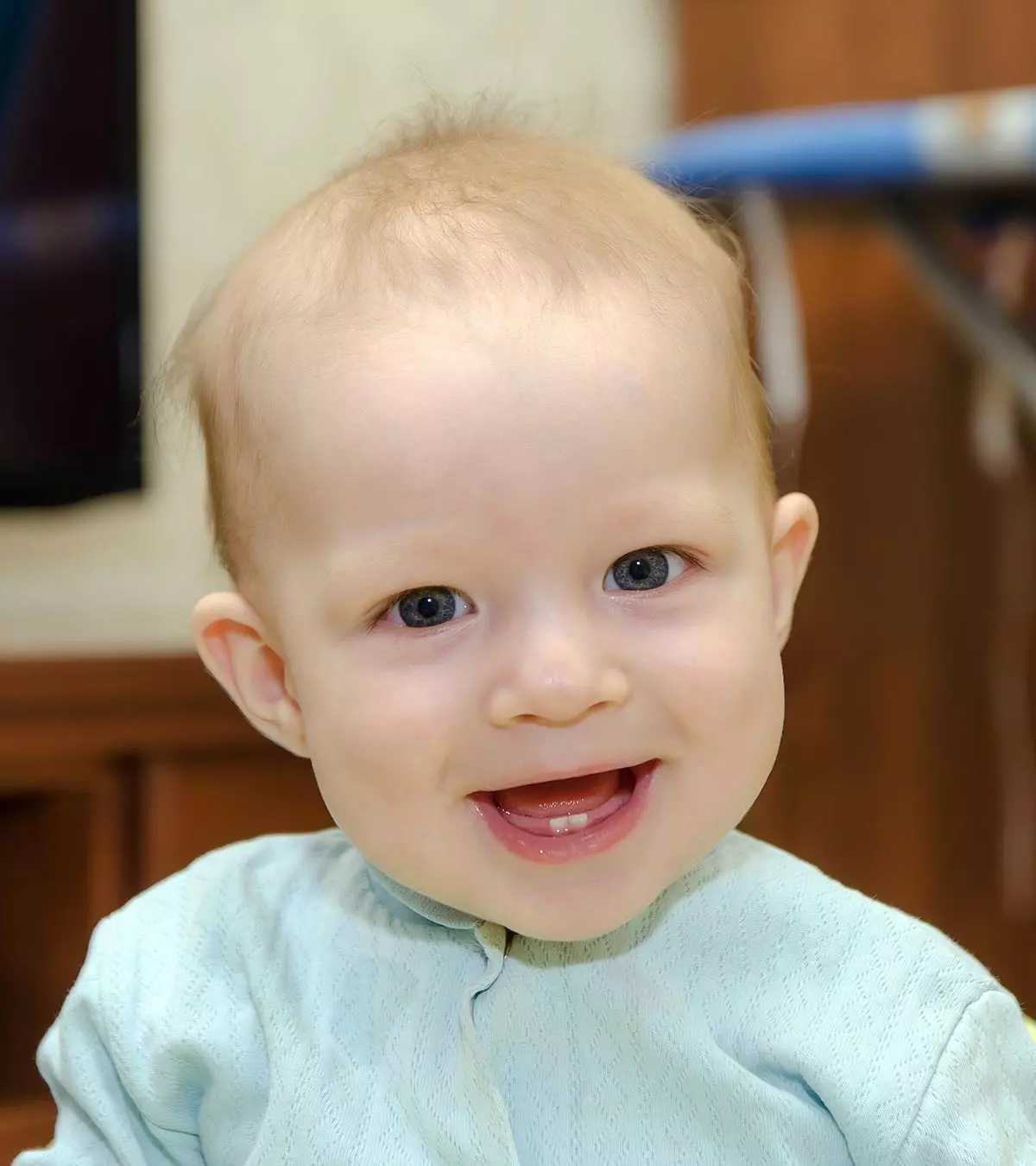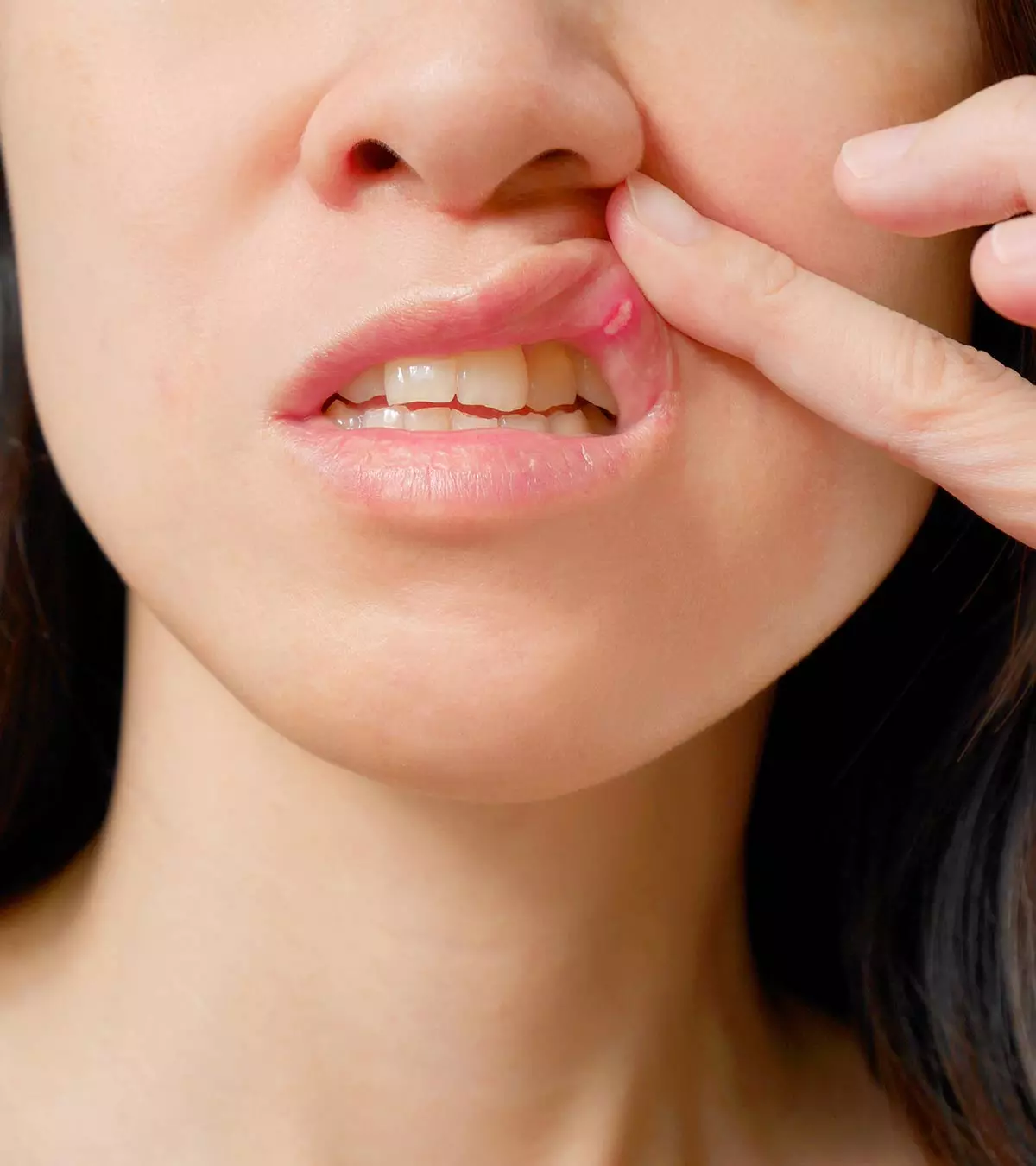
Image: ShutterStock
Natal teeth are the first teeth present from birth. Teeth formation begins in the fetus around the sixth week of gestation (1). These teeth are usually inside the gums and are not visible until fully formed. Therefore, most babies will have visible teeth a few months after birth. However, some babies are born with teeth, which is rare. These may cause discomfort to some and can be removed if they get loose. Keep reading the post to know about the causes and how natal teeth could affect the baby’s growth and development.

Key Pointers
- Natal teeth occur in approximately 1 in 7,000 to 30,000 births and are present at birth.
- These teeth are usually small, loose, and brown or yellow, and X-rays may be used to diagnose them.
- Complications for babies may include trouble latching, poor feeding, fussiness, biting, and choking.
- Around 90-99% of natal teeth are primary teeth that emerge early and will be replaced by permanent teeth later.
- Causes of natal teeth include genetic disorders, jaw abnormalities, and congenital or maternal infections.
What Are Natal Teeth And Are They Common?

Natal teeth, which are highly uncommon, are teeth that are present when the baby is born (1). These deciduous teeth develop prematurely in utero and are often referred to as precocious teeth or congenital teeth, which may or may not be fully formed.
Based on studies, the probability of a child being born with natal teeth can range from one in 7000 to one in 30,000 (2). Usually, there are no more than three natal teeth, and an infant’s chances of having natal teeth are the same, irrespective of gender.
 Quick fact
Quick factCan Natal Teeth Cause Problems For The Baby?
Yes, natal teeth may cause complications such as:
- Trouble latching to nipple: It is the leading complication observed among babies born with teeth. The presence of teeth can make it hard for the little one to properly latch onto the breast or bottle nipple, thus preventing uninterrupted feeding or leading to inadequate feeding.
- Poor feeding and impact on health: Since the baby does not feed properly, he does not get the essential nutrients. This could affect the baby’s overall development.
- Fussiness: In case the teeth are embedded within the gums, the pain may be similar to the pain experienced by a baby teething. This can make the baby irritable and fussy.

- Biting the nipple: A baby with natal teeth may nip either at the breast or the bottle nipple. Repeated biting may damage the bottle nipple or make breastfeeding difficult.
- Choking: A loose natal tooth could break and fall into the windpipe, resulting in fatal choking.
 Did you know?
Did you know?How Are Natal Teeth Removed?
Surgery is the only way to remove natal teeth. Keep reading for more information on the procedure (3):
- Pre-operative preparations: The surgery is done after the baby is at least ten days old when the baby develops intestinal flora (bacteria) that produces vitamin K that enables blood coagulation. This is essential for faster healing and preventing hemorrhage (excessive blood loss) during surgery. Usually, babies also receive vitamin K supplements before surgery.
- Natal teeth removal: The operation is performed under local anesthesia, which provides enough sedation to keep the baby calm through the surgery. Natal teeth removal is not likely to affect subsequent tooth eruptions.

- Post-operative care: More vitamin K could be administered intramuscularly, depending on the rate of healing. The baby is discharged within a few hours, and follow-up happens every week.
The pediatric dentist decides whether or not to remove natal teeth, after examining the extent of their interference in the baby’s growth and development. If the teeth are strongly rooted and have no impact on the baby’s feeding, then surgery may not be required.
When Is The Appropriate Time To Have Natal Teeth Extracted?
If natal teeth jeopardize the newborn’s well-being, a dentist or healthcare provider may recommend removal. This becomes necessary if the teeth are excessively loose or could be inhaled into the airway, leading to respiratory problems. The extraction is often done while the newborn is still in the hospital to help prevent the risk of the infant “breathing in” the tooth.
Additionally, extraction may be advised if natal teeth interfere with breastfeeding or cause tongue injuries. The decision of whether or not to remove natal teeth depends on the severity of the condition and the baby’s overall health (4).
Do Primary Teeth Replace Natal Teeth?
About 90-99% of natal teeth are primary teeth that have emerged before time. Only 1-10% are supernumerary teeth, or extra teeth in the mouth.
If the baby’s natal teeth are primary, they will be replaced by permanent teeth later. Otherwise, the baby will grow primary teeth first, followed by permanent teeth after the loss of the primaries.
What Are The Types Of Natal Teeth?
The following are the four types of natal teeth (5):
- Fully erupted: The teeth are entirely out of the gums and visible easily. The teeth do not move when touched and are firmly attached to the gums.
- Loose and fully erupted: Teeth are fully visible but are loosely attached to the gums, indicating the absence of roots or partial rooting.
- Partially erupted: An edge of the tooth’s crown is visible through the gums. The remainder of the teeth are embedded in the gums.
- Unerupted but visible: The teeth are entrenched but visible as a white bump on the gums.
Can Any Teeth Erupt As Natal Teeth?
Only the below-mentioned teeth emerge as natal teeth (3):
- Lower central incisors – 85%
- Upper incisors – 11%
- Lower canines and molars – 3%
- Upper canines and molars – 1%
The two lower central incisors are the most common types of natal teeth. It is significantly rare to be born with multiple sets of natal teeth.
Why Are Some Infants Born With Teeth?
The following are the most common reasons for babies having natal teeth (6):
- Hereditary: A baby is quite likely to be born with natal teeth if its parent, sibling, or an immediate relative had teeth at birth.
- Ellis-van Creveld syndrome: Also called chondroectodermal dysplasia (7), is a genetic bone disorder that causes a host of congenital abnormalities such as a total absence of hair, dental anomalies, the presence of extra teeth, and extra fingers (polydactyl on babies).
- Pierre Robin syndrome: A genetic disorder where the baby is born with an abnormally small lower jaw. One of the several complications of the condition is the presence of teeth at birth (8).
- Hallermann-Streiff syndrome or oculomandibulo-dyscephaly with hypotrichosis is a rare congenital genetic disorder that causes deformities of the skull like a shorter jaw, arched mouth palate and natal teeth (9). This condition is so rare that its exact causes are unknown and even treatment options are limited.
- Sotos syndrome is a genetic disease that causes accelerated growth during infancy and toddlerhood. Babies born with the condition often display the presence of teeth at birth (10).
- Jadassohn–Lewandowski syndrome, also called pachyonychia congenita, is caused by unfavorable genetic mutations. Infants born with the condition display thick nails and the presence of natal teeth (11).
- General jaw deformities: Natal teeth are also present in newborns with jaw abnormalities like cleft lip and cleft palate.

- Endocrine problems: Congenital hormonal problems can also cause natal teeth.
- Congenital and maternal infections: If the baby is born with an infection (contracted through the mother), then he may display natal teeth as a side effect. An example of such an illness is congenital syphilis. Also, if a mother has suffered from a serious illness or high fevers during pregnancy, then the infant could have natal teeth at birth.
What Is The Difference Between Natal And Neonatal Teeth?
Natal teeth are present at birth, while neonatal teeth, also called neonatal dentition, emerge within the first month (30 days) of the infant’s life. Natal teeth are three times more common than neonatal teeth, which are similar to natal teeth in appearance and where they emerge. Causes, complications, and treatment of neonatal teeth are also identical to that of natal teeth.
 Quick tip
Quick tipCan Natal And Neonatal Teeth Happen Simultaneously?

The two can happen together, but it is an extremely rare condition. The emergence of the two in succession is mainly observed in complex congenital genetic disorders.
Frequently Asked Questions
1. Is it rare for babies to be born with teeth?
Natal teeth are rare. Approximately one in 2000 to 3000 live-born babies have natal teeth, with the presence of lower primary central incisors being most common. The teeth may appear in pairs, but more than two natal teeth are rarely seen (12).
2. Are natal teeth lucky?
Various superstitions about natal teeth exist in different ethnic groups. In England, it is believed that those with natal teeth can conquer the world, and it is considered good fortune in Malaysian communities. Meanwhile, the Chinese community considers natal teeth a misfortune. Regardless of these beliefs, doctors may recommend removing or retaining natal teeth depending on the clinical situation (13).
3. What causes newborns to be born with teeth?
The exact causes are unknown. However, natal teeth are often seen with certain medical conditions affecting growth. It may be associated with Sotos syndrome with distinctive facial features and growth, Hallerman-Streiff syndrome with specific facial features and dental abnormalities, and other genetic disorders. However, it is also possible to have natal teeth without any underlying conditions (4).
4. Can babies born with teeth eat solid foods?
Babies can consume solids after six months (14). No study or evidence suggests a change in this pattern for babies with natal teeth.
5. Do natal teeth grow into normal teeth in babies?
Natal teeth are often primary teeth, or milk teeth, and fall off eventually. Studies suggest that most natal teeth fall out within the first year of life (15). Permanent teeth will eventually replace the teeth.
Babies born with natal teeth may face issues with latching nipples, and poor feeding can impact their optimal growth and development. Genetic abnormalities, maternal infections, and hereditary factors may cause babies to be born with teeth. They are also at increased risk of choking, and there is more chance to bite nipples than others. Feeding issues can make the babies more fussy and irritable. Natal teeth are surgically removed after ten days of birth since gut bacteria need this time to produce Vitamin K, required to prevent bleeding.
Infographic: Effects Of Natal Teeth On Babies
Although natal teeth (teeth present at birth) are rare, they can significantly impact a baby’s health and development. The reason for this is that natal teeth can affect the way a baby feeds and cause fussiness. Check out the infographic below to explore the potential effects of a baby having teeth at birth.
Some thing wrong with infographic shortcode. please verify shortcode syntaxReferences
- Natal teeth.
https://medlineplus.gov/ency/article/003268.htm - Roopa S Rao and Sudha V Mathad; Natal teeth: Case report and review of literature; J Oral Maxillofac Pathol (2009).
https://www.ncbi.nlm.nih.gov/pmc/articles/PMC3162856/ - N. Uma Maheswari et al.; “Early baby teeth”: Folklore and facts; J Pharm Bioallied Sci (2012).
https://www.ncbi.nlm.nih.gov/pmc/articles/PMC3467875/ - Natal Teeth.
https://www.stanfordchildrens.org/en/topic/default?id=natal-teeth-90-P01862 - Vishal Khandelwal et al.; Management of an infant having natal teeth; BMJ Case Rep (2013).
https://www.ncbi.nlm.nih.gov/pmc/articles/PMC3703024/ - NATAL AND NEONATAL TEETH : Folklore and Fact.
https://publications.aap.org/pediatrics/article-abstract/32/6/1087/41929/NATAL-AND-NEONATAL-TEETH-Folklore-and-Fact?redirectedFrom=PDF - Ellis-van Creveld syndrome.
https://medlineplus.gov/ency/article/001667.htm - Pierre Robin sequence.
https://medlineplus.gov/ency/article/001607.htm - Hallermann-Streiff syndrome.
https://rarediseases.info.nih.gov/diseases/288/hallermann-streiff-syndrome/ - Sotos syndrome.
https://rarediseases.info.nih.gov/diseases/10091/sotos-syndrome/ - Strober; Pachyonychia congenita, type II; University of California (2003).
https://escholarship.org/uc/item/1c23k0nn - Alexander K. C. Leung and William Lane M. Robson; 2006; Natal teeth: a review.
https://www.ncbi.nlm.nih.gov/pmc/articles/PMC2595049/#:~:text=The%20incidence%20of%20natal%20teeth - “Early baby teeth”: Folklore and facts.
https://www.researchgate.net/publication/232248473_Early_baby_teeth_Folklore_and_facts - Nutrition for Infants.
https://choc.org/programs-services/nutrition/nutrition-for-infants/ - Natal and neonatal teeth.
https://dermnetnz.org/topics/natal-and-neonatal-teeth - Riga-Fede disease.
https://dermnetnz.org/topics/riga-fede-disease - Natal teeth Information.
https://www.mountsinai.org/health-library/symptoms/natal-teeth
Community Experiences
Join the conversation and become a part of our nurturing community! Share your stories, experiences, and insights to connect with fellow parents.
Read full bio of Dr. Shailesh Shenoy
Read full bio of Rohit Garoo
Read full bio of Dr. Ritika Shah
Read full bio of Anindita Ghatak
















